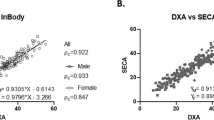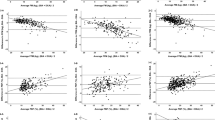Abstract
Background/objectives
Low agreement of body-composition analysis (BCA) using dual-energy X-ray absorptiometry (DXA) and multi-frequency bioelectrical impedance analysis (MF-BIA) has been reported. We examined whether this discrepancy is influenced by the precision of body weight (BW) measurement using DXA.
Subjects/methods
This cross-sectional study enrolled 1353 participants aged 53–83 years. A whole-body DXA scan and an eight-polar tactile-electrode impedance-meter using four electronic frequencies of 5, 50, 250, and 500 kHz were employed for BCA. The level of agreement between BW estimated using DXA and actual BW (WgtA) was calculated. The agreement of BCA parameters using DXA and MF-BIA across WgtA groups was also assessed.
Results
DXA incorrectly estimated BW, especially in men. In total, 13.5%, 5.1%, and 5.6% of the participants had BW bias levels of 2%, 3%, and ≥4%, respectively. Correlations of BCA parameters measured using DXA and MF-BIA, including body fat mass, percent body fat, and lean body mass (LBM), were gradually reduced, whereas the root mean square error was increased in accordance with the reduction in WgtA. DXA provided a lower LBM amount compared to MF-BIA and this difference increased significantly across groups with poor WgtA.
Conclusions
Lower WgtA greatly contributed to the difference in BCA measured using DXA and MF-BIA.
This is a preview of subscription content, access via your institution
Access options
Subscribe to this journal
Receive 12 print issues and online access
$259.00 per year
only $21.58 per issue
Buy this article
- Purchase on Springer Link
- Instant access to full article PDF
Prices may be subject to local taxes which are calculated during checkout




Similar content being viewed by others
References
Dulloo AG, Jacquet J, Solinas G, Montani JP, Schutz Y. Body composition phenotypes in pathways to obesity and the metabolic syndrome. Int J Obes. 2010;34(Suppl 2):S4–17.
Lukaski HC. Evolution of bioimpedance: a circuitous journey from estimation of physiological function to assessment of body composition and a return to clinical research. Eur J Clin Nutr. 2013;67(Suppl 1):S2–9.
Lloyd LJ, Langley-Evans SC, McMullen S. Childhood obesity and risk of the adult metabolic syndrome: a systematic review. Int J Obes. 2012;36:1–11.
Manolopoulos KN, Karpe F, Frayn KN. Gluteofemoral body fat as a determinant of metabolic health. Int J Obes. 2010;34:949–59.
Muller MJ, Lagerpusch M, Enderle J, Schautz B, Heller M, Bosy-Westphal A. Beyond the body mass index: tracking body composition in the pathogenesis of obesity and the metabolic syndrome. Obes Rev. 2012;13(Suppl 2):6–13.
Phillips CM, Tierney AC, Perez-Martinez P, Defoort C, Blaak EE, Gjelstad IM, et al. Obesity and body fat classification in the metabolic syndrome: impact on cardiometabolic risk metabotype. Obesity. 2013;21:E154–61.
Toombs RJ, Ducher G, Shepherd JA, De Souza MJ. The impact of recent technological advances on the trueness and precision of DXA to assess body composition. Obesity. 2012;20:30–9.
Plank LD. Dual-energy X-ray absorptiometry and body composition. Curr Opin Clin Nutr Metab Care. 2005;8:305–9.
Ward LC. Segmental bioelectrical impedance analysis: an update. Curr Opin Clin Nutr Metab Care. 2012;15:424–9.
Kim H, Kim CH, Kim DW, Park M, Park HS, Min SS, et al. External cross-validation of bioelectrical impedance analysis for the assessment of body composition in Korean adults. Nutr Res Pract. 2011;5:246–52.
Ling CH, de Craen AJ, Slagboom PE, Gunn DA, Stokkel MP, Westendorp RG, et al. Accuracy of direct segmental multi-frequency bioimpedance analysis in the assessment of total body and segmental body composition in middle-aged adult population. Clin Nutr. 2011;30:610–5.
Demura S, Sato S, Kitabayashi T. Percentage of total body fat as estimated by three automatic bioelectrical impedance analyzers. J Physiol Anthropol Appl Human Sci. 2004;23:93–9.
Sun G, French CR, Martin GR, Younghusband B, Green RC, Xie YG, et al. Comparison of multifrequency bioelectrical impedance analysis with dual-energy X-ray absorptiometry for assessment of percentage body fat in a large, healthy population. Am J Clin Nutr. 2005;81:74–8.
Talma H, Chinapaw MJ, Bakker B, HiraSing RA, Terwee CB, Altenburg TM. Bioelectrical impedance analysis to estimate body composition in children and adolescents: a systematic review and evidence appraisal of validity, responsiveness, reliability and measurement error. Obes Rev. 2013;14:895–905.
Arngrimsson S, Evans EM, Saunders MJ, Ogburn CL 3rd, Lewis RD, Cureton KJ. Validation of body composition estimates in male and female distance runners using estimates from a four-component model. Am J Hum Biol. 2000;12:301–14.
Deurenberg-Yap M, Schmidt G, van Staveren WA, Hautvast JG, Deurenberg P. Body fat measurement among Singaporean Chinese, Malays and Indians: a comparative study using a four-compartment model and different two-compartment models. Br J Nutr. 2001;85:491–8.
Schoeller DA, Tylavsky FA, Baer DJ, Chumlea WC, Earthman CP, Fuerst T, et al. QDR 4500A dual-energy X-ray absorptiometer underestimates fat mass in comparison with criterion methods in adults. Am J Clin Nutr. 2005;81:1018–25.
Goran MI, Driscoll P, Johnson R, Nagy TR, Hunter G. Cross-calibration of body-composition techniques against dual-energy X-ray absorptiometry in young children. Am J Clin Nutr. 1996;63:299–305.
Kim Y, Han BG, KoGES group. Cohort profile: The Korean Genome and Epidemiology Study (KoGES) Consortium. Int J Epidemiol. 2016;46:e20.
Fisher RA. On the probable error of a coefficient of correlation deduced from a small sample. Metron. 1921;1:3–32.
Sillanpaa E, Cheng S, Hakkinen K, Finni T, Walker S, Pesola A, et al. Body composition in 18- to 88-year-old adults--comparison of multifrequency bioimpedance and dual-energy X-ray absorptiometry. Obesity. 2014;22:101–9.
Blaak E. Gender differences in fat metabolism. Curr Opin Clin Nutr Metab Care. 2001;4:499–502.
Leahy S, O’Neill C, Sohun R, Jakeman P. A comparison of dual energy X-ray absorptiometry and bioelectrical impedance analysis to measure total and segmental body composition in healthy young adults. Eur J Appl Physiol. 2012;112:589–95.
Van Der Ploeg GE, Withers RT, Laforgia J. Percent body fat via DEXA: comparison with a four-compartment model. J Appl Physiol. 2003;94:499–506.
Krueger D, Vallarta-Ast N, Checovich M, Gemar D, Binkley N. BMD measurement and precision: a comparison of GE Lunar Prodigy and iDXA densitometers. J Clin Densitom. 2012;15:21–5.
Malouf J, DiGregorio S, Del Rio L, Torres F, Marin AM, Farrerons J, et al. Fat tissue measurements by dual-energy x-ray absorptiometry: cross-calibration of 3 different fan-beam instruments. J Clin Densitom. 2013;16:212–22.
Anderson LJ, Erceg DN, Schroeder ET. Utility of multifrequency bioelectrical impedance compared with dual-energy x-ray absorptiometry for assessment of total and regional body composition varies between men and women. Nutr Res. 2012;32:479–85.
Funding
This research was supported by a fund (2014-E71003-00) from the research of Korea Centers for Disease Control and Prevention and the Bio & Medical Technology Development Program of the National Research Foundation (NRF) funded by the Ministry of Science, ICT & Future Planning (Nos. 10068076, 2014M3A9D7034366, 2015M3A9B6028310).
Author contributions
CS, SKL, and NHK designed and supervised the Korean Genome and Epidemiology Study (KoGES), defined the research theme and edited the manuscript. DDP and CHL designed the methods, analyzed the data, interpreted the results, and wrote the manuscript. All authors read and approved the final manuscript.
Author information
Authors and Affiliations
Corresponding authors
Ethics declarations
Conflict of interest
The authors declare that they have no conflict of interest.
Electronic supplementary material
41430_2018_164_MOESM2_ESM.docx
Table 1S. Comparison of difference in body composition analysis (BCA) by DXA versus MF-BIA of Shillanpaa et al and of the BW matched group in the current study
Rights and permissions
About this article
Cite this article
Pham, D.D., Lee, S.K., Shin, C. et al. Body weight difference between dual-energy X-ray absorptiometry and multi-frequency bioelectrical impedance analysis attenuates the equivalence of body-composition assessment. Eur J Clin Nutr 73, 387–394 (2019). https://doi.org/10.1038/s41430-018-0164-4
Received:
Revised:
Accepted:
Published:
Issue Date:
DOI: https://doi.org/10.1038/s41430-018-0164-4



